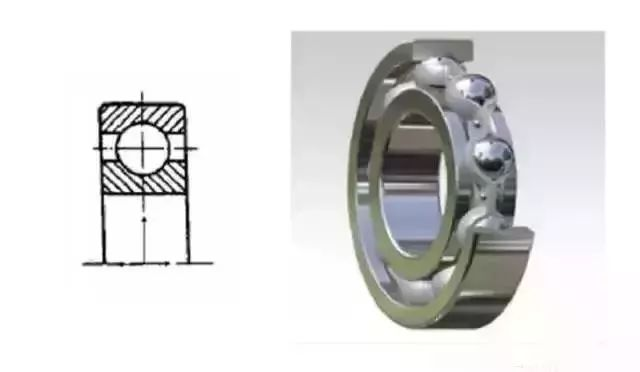Bearings are important components in mechanical equipment. Its main function is to support the mechanical rotating body to reduce the friction coefficient of the mechanical load during the transmission process of the equipment.
Bearings are divided into radial bearings and thrust bearings according to different load-carrying directions or nominal contact angles.
According to the type of rolling elements, they are divided into: ball bearings and roller bearings.
According to whether they can be aligned, they are divided into: self-aligning bearings and non-aligning bearings (rigid bearings).
According to the number of rows of rolling elements, they are divided into: single-row bearings, double-row bearings, and multi-row bearings.
According to whether the components can be separated, they are divided into: separable bearings and non-separable bearings.
There are also classifications based on structural shape and size.
This article mainly shares the characteristics, differences and corresponding uses of 14 common bearings.
1 Angular contact ball bearings
There is a contact angle between the ferrule and the ball. The standard contact angles are 15°, 30° and 40°. The larger the contact angle, the greater the axial load capacity. The smaller the contact angle, the more conducive to high-speed rotation. Single-row bearings can Bear radial load and unidirectional axial load. Structurally, two single-row angular contact ball bearings combined on the back share the inner ring and outer ring and can bear radial load and bidirectional axial load.
The main purpose:
Single row: machine tool spindle, high-frequency motor, gas turbine, centrifugal separator, small car front wheel, differential pinion shaft.
Double row: oil pumps, Roots blowers, air compressors, various transmissions, fuel injection pumps, printing machinery.
2 Aligning ball bearings
Double rows of steel balls, the outer ring raceway is an inner spherical type, so it can automatically adjust the shaft center misalignment caused by deflection or non-concentricity of the shaft or housing. The tapered bore bearing can be easily installed on the shaft by using fasteners. Mainly Bear radial load.
Main uses: woodworking machinery, textile machinery drive shafts, vertical seated self-aligning bearings.
3 Spherical roller bearing
This type of bearing is equipped with spherical rollers between the spherical raceway outer ring and the double raceway inner ring. According to the different internal structures, it is divided into four types: R, RH, RHA and SR. Since the arc center of the outer ring raceway is The bearing center is consistent and has self-aligning performance, so it can automatically adjust the shaft center misalignment caused by deflection or non-concentricity of the shaft or housing, and can withstand radial loads and bidirectional axial loads.
Main uses: papermaking machinery, reduction gears, railway vehicle axles, rolling mill gearbox seats, rolling mill rollers, crushers, vibrating screens, printing machinery, woodworking machinery, various industrial reducers, vertical seated spherical bearings .
4 Thrust spherical roller bearing
The spherical rollers in this type of bearing are arranged obliquely. Since the raceway surface of the seat ring is spherical and has self-aligning properties, it can allow the shaft to tilt to some extent. The axial load capacity is very large. It can bear several axial loads at the same time. Radial load, oil lubrication is generally used when in use.
Main uses: hydraulic generators, vertical motors, propeller shafts for ships, reducers for rolling screws in rolling mills, tower cranes, coal mills, extruders, and forming machines.
5 Tapered Roller Bearings
This type of bearing is equipped with truncated conical rollers. The rollers are guided by the large ribs of the inner ring. They are designed so that the apexes of the conical surfaces of the inner ring raceway surface, outer ring raceway surface and roller rolling surface intersect at the center line of the bearing. On point. Single-row bearings can bear radial load and one-way axial load, while double-row bearings can bear radial load and two-way axial load, and are suitable for bearing heavy loads and impact loads.
Main uses: Automobiles: front wheels, rear wheels, transmissions, differential pinion shafts. Machine tool spindles, construction machinery, large agricultural machinery, railway vehicle gear reduction devices, rolling mill roll necks and reduction devices.
6 Deep groove ball bearing
Structurally, each ring of a deep groove ball bearing has a continuous groove raceway with a cross-section approximately one-third of the equatorial circumference of the ball. Deep groove ball bearings are mainly used to bear radial loads and can also bear certain axial loads.
When the radial clearance of the bearing increases, it has the properties of an angular contact ball bearing and can withstand alternating axial loads in two directions. Compared with other types of bearings of the same size, this type of bearing has a small friction coefficient, a high limit speed, and high precision. It is the preferred bearing type for users when selecting.
Main uses: automobiles, tractors, machine tools, motors, water pumps, agricultural machinery, textile machinery, etc.
7 Thrust ball bearing
It consists of a washer-shaped raceway ring with a raceway and a ball and cage assembly. The raceway ring that matches the shaft is called a shaft ring, and the raceway ring that matches the shell is called a seat ring. The two-way bearing matches the secret shaft of the middle ring. The one-way bearing can bear one-way axial load, and the two-way bearing can bear two-way axial load (neither can bear radial load).
Main uses: automobile steering pins, machine tool spindles.
Xinfa CNC tools have the characteristics of good quality and low price. For details, please visit:
CNC Tools Manufacturers – China CNC Tools Factory & Suppliers (xinfatools.com)
Post time: Oct-26-2023










